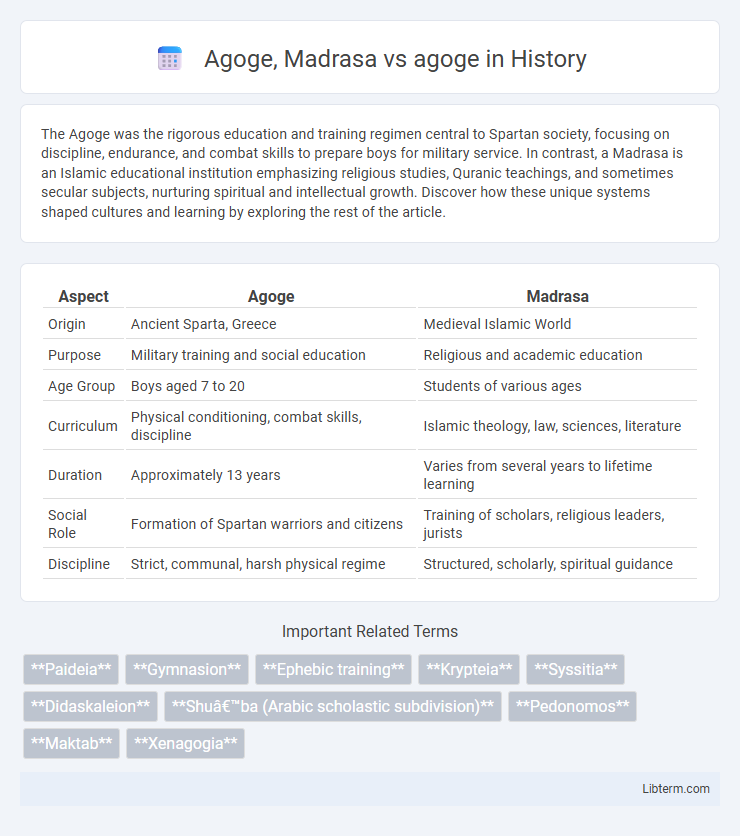The Agoge was the rigorous education and training regimen central to Spartan society, focusing on discipline, endurance, and combat skills to prepare boys for military service. In contrast, a Madrasa is an Islamic educational institution emphasizing religious studies, Quranic teachings, and sometimes secular subjects, nurturing spiritual and intellectual growth. Discover how these unique systems shaped cultures and learning by exploring the rest of the article.
Table of Comparison
| Aspect | Agoge | Madrasa |
|---|---|---|
| Origin | Ancient Sparta, Greece | Medieval Islamic World |
| Purpose | Military training and social education | Religious and academic education |
| Age Group | Boys aged 7 to 20 | Students of various ages |
| Curriculum | Physical conditioning, combat skills, discipline | Islamic theology, law, sciences, literature |
| Duration | Approximately 13 years | Varies from several years to lifetime learning |
| Social Role | Formation of Spartan warriors and citizens | Training of scholars, religious leaders, jurists |
| Discipline | Strict, communal, harsh physical regime | Structured, scholarly, spiritual guidance |
Introduction to Agoge and Madrasa
Agoge was the rigorous education and training system in ancient Sparta, emphasizing physical strength, discipline, and military skills to prepare boys for warrior roles. Madrasa, historically rooted in Islamic culture, serves as an educational institution focusing on religious instruction, Quranic studies, and classical sciences. The Agoge centers on state-driven militaristic development, while the Madrasa prioritizes religious and scholarly learning within community-based frameworks.
Historical Background of the Agoge
The Agoge was the rigorous education and training system used in ancient Sparta, designed to mold male citizens into disciplined warriors and loyal soldiers from childhood to adulthood. It emphasized physical endurance, military skills, obedience, and communal living, reflecting Sparta's militaristic society and social hierarchy starting around the 7th century BCE. Unlike the Islamic Madrasa system, which centers on religious and academic studies, the Agoge's historical background embodies a state-controlled program prioritizing martial excellence and civic duty in a militarized polis.
Origins and Development of the Madrasa
The madrasa originated in the early Islamic world during the 10th century as an educational institution focused on religious and legal studies, evolving to incorporate diverse subjects such as philosophy, mathematics, and science. Unlike the Agoge, the Spartan military training system centered on physical discipline and martial skills, madrasas emphasized intellectual development and scholarly pursuits in Islamic civilization. Over centuries, madrasas became integral to Islamic culture, influencing education throughout the Middle East, North Africa, and South Asia.
Core Principles of Spartan Agoge
The Spartan Agoge emphasized rigorous physical training, discipline, and communal living to cultivate loyalty, resilience, and martial prowess. Unlike traditional madrasas that focus primarily on religious education and intellectual development, the Agoge's core principles revolved around obedience, endurance, and combat skills essential for producing elite warriors. This system instilled a collective Spartan identity, fostering cooperation and sacrifice for the state above individual interests.
Educational Philosophy of the Madrasa
The Madrasa educational philosophy emphasizes the holistic development of students through a curriculum rooted in Islamic theology, jurisprudence, and classical sciences, promoting moral and spiritual growth alongside intellectual achievement. Unlike the Agoge, which focused on rigorous physical training and militaristic discipline to prepare Spartan youth for warfare, the Madrasa cultivates intellectual inquiry and ethical conduct within a structured religious framework. Core objectives of the Madrasa include fostering critical thinking, memorization of the Quran, and mastery of Arabic language to support lifelong learning and societal leadership roles.
Curriculum and Training Methods: Agoge vs Madrasa
The Agoge system, central to Spartan education, emphasized rigorous physical training, discipline, and military preparedness, integrating endurance exercises, combat skills, and communal living to develop elite warriors. In contrast, the Madrasa curriculum focused on Islamic religious instruction, including Quranic studies, jurisprudence (fiqh), grammar, and rhetoric, employing memorization, recitation, and scholarly debate as primary teaching methods. While Agoge prioritized physical conditioning and strategic warfare training to serve Spartan society, Madrasas aimed to deepen spiritual understanding and legal knowledge within the Islamic tradition.
Social and Cultural Impact of Agoge
Agoge, the rigorous Spartan education and training system, shaped societal cohesion by instilling discipline, loyalty, and communal values critical for military success and civic unity. Unlike the religious and intellectual focus of a madrasa, agoge's social impact emphasized collective strength and Spartan identity through physical endurance and group rites. This cultivation of shared cultural norms reinforced Sparta's militaristic society and legacy in ancient Greek history.
Madrasa’s Influence on Islamic Society
The Agoge was the rigorous education and training system in ancient Sparta, emphasizing physical fitness, discipline, and military skills, whereas the Madrasa served as a pivotal institution for Islamic education, promoting religious, legal, and scientific knowledge across the Muslim world. Madrasas played a crucial role in shaping Islamic society by fostering scholarly communities, preserving and interpreting Islamic law (Sharia), and advancing fields such as theology, philosophy, and medicine. The widespread establishment of madrasas from the 10th century onward facilitated the intellectual and cultural development of Islamic civilization, influencing governance, jurisprudence, and social structures.
Key Differences Between Agoge and Madrasa
Agoge was an ancient Spartan education system emphasizing military training, discipline, and physical endurance, designed to prepare boys for warrior roles. In contrast, Madrasa is an Islamic educational institution focused on religious studies, including Quranic teachings, Arabic, and jurisprudence. Key differences include Agoge's focus on martial skills and communal living versus Madrasa's emphasis on religious scholarship and individual memorization of texts.
Legacy and Modern Relevance of Agoge and Madrasa
The Agoge, an ancient Spartan educational system, emphasized rigorous physical training, discipline, and communal living, forging resilient warriors whose legacy influenced military and leadership practices. In contrast, the Madrasa, rooted in Islamic tradition, centers on religious, legal, and philosophical education, shaping scholars who preserve and develop Islamic knowledge. Both systems hold modern relevance: the Agoge inspires contemporary leadership and fitness programs emphasizing resilience and teamwork, while Madrasas continue to be pivotal in religious education and cultural identity within Muslim communities worldwide.
Agoge, Madrasa Infographic

 libterm.com
libterm.com